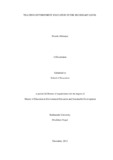
Please use this identifier to cite or link to this item:
https://hdl.handle.net/20.500.14301/255| Title: | TEACHING ENVIRONMENT EDUCATION IN THE SECONDARY LEVEL |
| Authors: | Maharjan, Pramila |
| Citation: | Maharjan,P.(2012).Teaching environment education in the secondary level. |
| Issue Date: | Dec-2012 |
| School: | SOED |
| Department: | DODE |
| Level: | Masters |
| Program: | KUMSD |
| Abstract: | This study attempted to explore the present practice of teaching learning of Environment Education in the Secondary Level Public Schools. The qualitative research approach was followed with interpretive research paradigm to conduct this research. I studied the teaching practices of Environment Education in the secondary level curriculum with the subject Health, Population and Environment, a major subject in grade nine and ten. More particularly, it revealed the understanding of environment education by teachers; teaching methods applied, use of teaching materials and problems encountered by teachers while teaching environment education and drew some implications on the basis of findings and conclusion. The research was carried out in six different public schools of Lalitpur Sub Metropolitan City with nine respondents who are currently teaching Health Population and Environment in the secondary level. I used open ended questionnaire, participant observation and focused group discussion to collect the qualitative data. During the process of data collection and data analysis, I was highly engrossed with the respondents and their experiences. ii After completing my study, I came up with conclusion that environment education is the most important aspect of education in present days so as to create awareness on environment degradation. Basically, environment education is being taught from the junior levels in schools infused in different subjects like Social Studies, Science, Nepali, and English. In the context of Nepal, environment education teaching is included from the primary level, whereas Health, Population and Environment is a particular subject which meets the objectives of environment education in the secondary level. The study revealed the teachers understanding on environment education being important aspect which is imparted to students through Health, Population and Environment subject. The teachers have been teaching with limited teaching materials confined within classroom teaching and the method of teaching has been mostly through the lecture method. Although the teachers have been teaching in lecture method, students were found aware about environment, hygiene and sanitation. They are using dustbin in the classrooms and participated in road cleaning campaign which depicted the importance of environment education teaching but they still lacked in developing responsible behavior towards environment. This is because the education system in present context is focused on exam basis rather than preparing for their behavioral change. The research also concluded with the implications deduced from the study. The teachers expressed their view of outdoor teaching to be more effective than direct classroom teaching in order to meet the goals of environment education. The teachers, currently teaching Health, Population and Environment in the research site expressed positive belief towards meeting environment education goals but they have been encountering various problems like lack of teaching materials and large class size. In iii addition to that, teachers were found to be from different academic background irrelevant to subject matter who are currently teaching Health, Population and Environment resulting in the teaching difficulties in core chapters such as health portion. Lastly, the research in the field of environment education is essential in order to probe various problems and possibilities which will help to protect and conserve our Planet. |
| URI: | https://hdl.handle.net/20.500.14301/255 |
| Appears in Collections: | Research Project |
Files in This Item:
| File | Description | Size | Format | |
|---|---|---|---|---|
| Pramila_Maharjan_MEd EESD2008 batch.pdf | 777.47 kB | Adobe PDF |  View/Open |
Items in DSpace are protected by copyright, with all rights reserved, unless otherwise indicated.